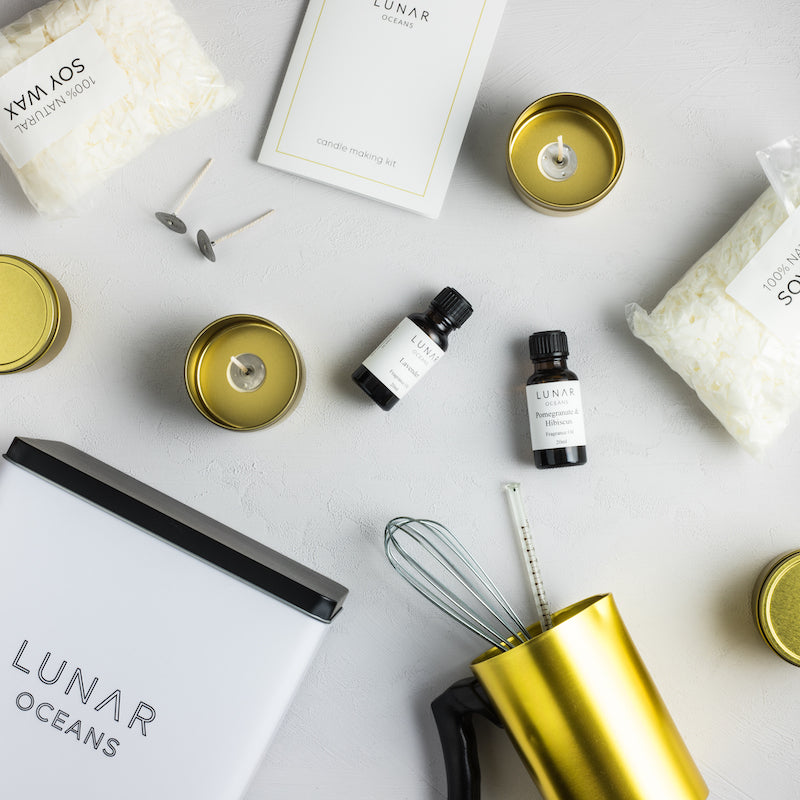Here at Lunar Oceans, we are frequently asked about the ingredients used in our range of scented products. Common questions include “Are your fragrances all natural?” and “Do you use 100% essential oils?” In this article we’ll address those questions and others, explain why we make our products the way we do, and dig into the science and history of scents along the way.

Natural or Synthetic?
The terms natural and synthetic are often used in a binary fashion, as though they were opposites and the former inherently better than the latter. When it comes to the ingredients used in modern-day cosmetics, perfumes, and home scents, this binary distinction is often not only unhelpful—but also surprisingly erroneous. In terms of scent quality, health safety, and environmental sustainability, man-made ingredients are in many cases superior to those derived from nature. Additionally, many “synthetic” compounds are chemically identical to their “natural” counterparts.

Lunar Oceans makes use of both pure essential oils and synthetic molecules in our candle and diffuser fragrances. We don’t test on animals, and our products are all non-toxic.
A short history of scents
The invention of perfume is generally attributed to the Ancient Egyptians, who used fragrant oils and resins from plants in their religious ceremonies and for hygienic purposes. Later, in Ancient Greek society, perfumes played a role in ordinary daily life for both sacred and secular activities. The Greeks infused olive oil with extractions from herbs and flowers including marjoram, violets, and lilies, and imported spices including cinnamon, cassia bark, and ginger.
By the Renaissance period, perfumery had developed into an industry, meeting the needs of the wealthy for whom scents were both fashionable and could mask body odours. Louis XV, King of France through the mid-eighteenth century, received a new perfume formula every day. Eau de Cologne, a blend of neroli, rosemary, bergamot, and lemon oils, originated during this time. In the nineteenth century the development of modern chemistry, with the creation of the first man-made essences, gave rise to modern perfumery.

Ingredients in fragrance today
Essential oils are volatile oils derived from plants through a variety of processes, ranging from distillation and boiling, to dissolving in alcohol and mechanical extraction. Because essential oils are obtained from raw organic matter, availability of the substances is directly tied to farming conditions, the climate, natural disasters, and political upheaval in regions where the plants and trees are grown. Many aromatic plants and flowers express a negligible amount of oil, making them uneconomical to harvest.
Some natural oils can go rancid shortly after extraction. The smell of an essential oil can be complex, as the scent is made up of hundreds of different individual scent molecules. This complexity can actually mean a lack of versatility when it comes to creating scent blends and more nuanced, elegant aromas. The number of quality, extractable plants for use in fragrance is around 200.

Man-made molecules are often exact chemical copies of their natural counterparts. Only a small fraction of flowering plant species contain essential oils; for those that don’t, the same scent can be produced with man-made compounds, synthesized by fragrance manufacturers in a laboratory. It has also been possible for perfumers to create scents that do not exist in distillable-form in nature. Because man-made molecules are generated as single molecules rather than as compounds, they can be combined together and with essential oils to produce delicate, varied, and sophisticated fragrance blends. Generally, high-quality synthetic elements are more inexpensive to produce than essential oils. Unexpected environmental changes are also not a factor. The number of additional scents provided to the industry by man-made molecules is around 2,000.
A word on safety
Both natural and synthetic molecules, such as cinnamon, linalool, and rose oil, can be harmful at certain levels. International regulations exist that limited and prohibit the use of ingredients in fragrance products for consumer safety. Some essential oils and man-made molecules can be skin aggravating and allergenic. For example, citrus oils can be phototoxic and some essential oils can cause complications in pregnant women. Man-made molecule levels are easier to control in products, meaning synthetic compounds are less commonly allergy-inducing. Some natural oils are more restricted in the industry.
We hope that this article has dispelled some of the myths around the ingredients used in perfumes and home fragrances, and explained why you can trust that your Lunar Oceans products are high-quality, safe, and responsibly-sourced.


